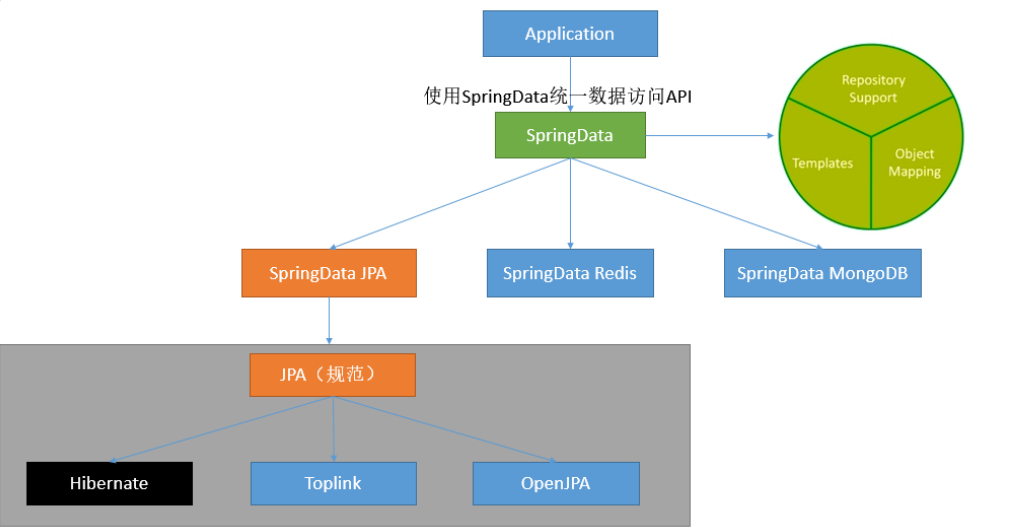SpringBoot与数据层
1、JDBC
- <dependency>
- <groupId>org.springframework.boot</groupId>
- <artifactId>spring‐boot‐starter‐jdbc</artifactId>
- </dependency>
- <dependency>
- <groupId>mysql</groupId>
- <artifactId>mysql‐connector‐java</artifactId>
- <scope>runtime</scope>
- </dependency>
- spring:
- datasource:
- username: root
- password: 123456
- url: jdbc:mysql://192.168.15.22:3306/jdbc
- driver‐class‐name: com.mysql.jdbc.Driver
效果:
默认是用org.apache.tomcat.jdbc.pool.DataSource作为数据源;
数据源的相关配置都在DataSourceProperties里面;
自动配置原理:
org.springframework.boot.autoconfigure.jdbc:
1、参考DataSourceConfiguration,根据配置创建数据源,默认使用Tomcat连接池;可以使用
spring.datasource.type指定自定义的数据源类型;
2、SpringBoot默认可以支持;
org.apache.tomcat.jdbc.pool.DataSource、HikariDataSource、BasicDataSource、
3、自定义数据源类型
- /**
- * Generic DataSource configuration.
- */
- @ConditionalOnMissingBean(DataSource.class)
- @ConditionalOnProperty(name = "spring.datasource.type")
- static class Generic {
- @Bean
- public DataSource dataSource(DataSourceProperties properties) {
- //使用DataSourceBuilder创建数据源,利用反射创建响应type的数据源,并且绑定相关属性
- return properties.initializeDataSourceBuilder().build();
- }
- }
4、DataSourceInitializer:ApplicationListener;
作用:
1)、runSchemaScripts();运行建表语句;
2)、runDataScripts();运行插入数据的sql语句;
默认只需要将文件命名为:
- schema‐*.sql、data‐*.sql
- 默认规则:schema.sql,schema‐all.sql;
- 可以使用
- schema:
- ‐ classpath:department.sql
- 指定位置
5、操作数据库:自动配置了JdbcTemplate操作数据库
2、整合Druid数据源
- 导入druid数据源
- @Configuration
- public class DruidConfig {
- @ConfigurationProperties(prefix = "spring.datasource")
- @Bean
- public DataSource druid(){
- return new DruidDataSource();
- }
- //配置Druid的监控
- //1、配置一个管理后台的Servlet
- @Bean
- public ServletRegistrationBean statViewServlet(){
- ServletRegistrationBean bean = new ServletRegistrationBean(new StatViewServlet(),
- "/druid/*");
- Map<String,String> initParams = new HashMap<>();
- initParams.put("loginUsername","admin");
- initParams.put("loginPassword","123456");
- initParams.put("allow","");//默认就是允许所有访问
- initParams.put("deny","192.168.15.21");
- bean.setInitParameters(initParams);
- return bean;
- }
- //2、配置一个web监控的filter
- @Bean
- public FilterRegistrationBean webStatFilter(){
- FilterRegistrationBean bean = new FilterRegistrationBean();
- bean.setFilter(new WebStatFilter());
- Map<String,String> initParams = new HashMap<>();
- initParams.put("exclusions","*.js,*.css,/druid/*");
- bean.setInitParameters(initParams);
- bean.setUrlPatterns(Arrays.asList("/*"));
- return bean;
- }
- }
3、整合MyBatis
- <dependency>
- <groupId>org.mybatis.spring.boot</groupId>
- <artifactId>mybatis‐spring‐boot‐starter</artifactId>
- <version>1.3.1</version>
- </dependency>

步骤:
1)、配置数据源相关属性(见上一节Druid)
2)、给数据库建表
3)、创建JavaBean
4)、注解版
- //指定这是一个操作数据库的mapper
- @Mapper
- public interface DepartmentMapper {
- @Select("select * from department where id=#{id}")
- public Department getDeptById(Integer id);
- @Delete("delete from department where id=#{id}")
- public int deleteDeptById(Integer id);
- @Options(useGeneratedKeys = true,keyProperty = "id")
- @Insert("insert into department(departmentName) values(#{departmentName})")
- public int insertDept(Department department);
- @Update("update department set departmentName=#{departmentName} where id=#{id}")
- public int updateDept(Department department);
- }
问题:
自定义MyBatis的配置规则;给容器中添加一个ConfigurationCustomizer;
- @org.springframework.context.annotation.Configuration
- public class MyBatisConfig {
- @Bean
- public ConfigurationCustomizer configurationCustomizer(){
- return new ConfigurationCustomizer(){
- @Override
- public void customize(Configuration configuration) {
- configuration.setMapUnderscoreToCamelCase(true);
- }
- };
- }
- }
- 使用MapperScan批量扫描所有的Mapper接口;
- @MapperScan(value = "com.atguigu.springboot.mapper")
- @SpringBootApplication
- public class SpringBoot06DataMybatisApplication {
- public static void main(String[] args) {
- SpringApplication.run(SpringBoot06DataMybatisApplication.class, args);
- }
- }
5)、配置文件版
- mybatis:
- config‐location: classpath:mybatis/mybatis‐config.xml 指定全局配置文件的位置
- mapper‐locations: classpath:mybatis/mapper/*.xml 指定sql映射文件的位置
更多使用参照
http://www.mybatis.org/spring-boot-starter/mybatis-spring-boot-autoconfigure/
4、整合SpringData JPA
1)、SpringData简介

2)、整合SpringData JPA
JPA:ORM(Object Relational Mapping);
1)、编写一个实体类(bean)和数据表进行映射,并且配置好映射关系;
- //使用JPA注解配置映射关系
- @Entity //告诉JPA这是一个实体类(和数据表映射的类)
- @Table(name = "tbl_user") //@Table来指定和哪个数据表对应;如果省略默认表名就是user;
- public class User {
- @Id //这是一个主键
- @GeneratedValue(strategy = GenerationType.IDENTITY)//自增主键
- private Integer id;
- @Column(name = "last_name",length = 50) //这是和数据表对应的一个列
- private String lastName;
- @Column //省略默认列名就是属性名
- private String email;
2)、编写一个Dao接口来操作实体类对应的数据表(Repository)
- //继承JpaRepository来完成对数据库的操作
- public interface UserRepository extends JpaRepository<User,Integer> {
- }
3)、基本的配置JpaProperties
- spring:
- jpa:
- hibernate:
- # 更新或者创建数据表结构
- ddl‐auto: update
- # 控制台显示SQL
- show‐sql: true
SpringBoot与数据层的更多相关文章
- Spring Boot 系列(九)数据层-集成Spring-data-jpa
实际开发中,不可避免地会对数据进行反复的增删改查操作,然而这部分工作是十分繁琐枯燥的.那么,随即而生的ORM框架就能很好的解决这个问题. 我们常用的ORM框架有:Hibernate.Mybatis.J ...
- Spring Boot 2.X(二):集成 MyBatis 数据层开发
MyBatis 简介 概述 MyBatis 是一款优秀的持久层框架,支持定制化 SQL.存储过程以及高级映射.它采用面向对象编程的方式对数据库进行 CRUD 的操作,使程序中对关系数据库的操作更方便简 ...
- SpringBoot之数据访问和事务-专题三
SpringBoot之数据访问和事务-专题三 四.数据访问 4.1.springboot整合使用JdbcTemplate 4.1.1 pom文件引入 <parent> <groupI ...
- 【开源】OSharp框架解说系列(5.2):EntityFramework数据层实现
OSharp是什么? OSharp是个快速开发框架,但不是一个大而全的包罗万象的框架,严格的说,OSharp中什么都没有实现.与其他大而全的框架最大的不同点,就是OSharp只做抽象封装,不做实现.依 ...
- 【开源】OSharp框架解说系列(5.1):EntityFramework数据层设计
OSharp是什么? OSharp是个快速开发框架,但不是一个大而全的包罗万象的框架,严格的说,OSharp中什么都没有实现.与其他大而全的框架最大的不同点,就是OSharp只做抽象封装,不做实现.依 ...
- 【类库】私房干货.Net数据层方法的封装
[类库]私房干货.Net数据层方法的封装 作者:白宁超 时间:2016年3月5日22:51:47 摘要:继上篇<Oracle手边常用70则脚本知识汇总>文章的发表,引起很多朋友关注.便促使 ...
- 23、ASP.NET MVC入门到精通——业务层和数据层父类及接口-T4模板
本系列目录:ASP.NET MVC4入门到精通系列目录汇总 在上一篇中,我们已经把项目的基本框架搭起来了,这一篇我们就来实现业务层和数据层的父接口及父类. 1.我们先来定义一个业务层父接口IBaseB ...
- 【转】Caffe初试(四)数据层及参数
要运行caffe,需要先创建一个模型(model),如比较常用的Lenet,Alex等,而一个模型由多个层(layer)构成,每一层又由许多参数组成.所有的参数都定义在caffe.proto这个文件中 ...
- C#在数据层过滤属性中的主键
C#使用泛型+反射做为数据层时,一个很都头疼的问题,如何让C#属性在程序里识别出哪个属性是主键,在拼接SQL时,不能把主键拼接到SQL语句里. 这个需要自定义一个属性.新建一个类文件,命名为Prosp ...
随机推荐
- 提示用户输入一个1-40之间的数字,使用if语句根据输入数字的大小进行判断,如果输入的数字在
提示用户输入一个1-40之间的数字,使用if语句根据输入数字的大小进行判断,如果输入的数字在 num_user=input('输入一个1-40之间的整数:') num_int=int(num_user ...
- 【开发必备】2018最新中国国内可用API合集
中国国内可用API合集 笔记 OneNote - OneNote支持获取,复制,创建,更新,导入与导出笔记,支持为笔记添加多媒体内容,管理权限等.提供SDK和Demo. 为知笔记 - 为知笔记Wind ...
- i++和++i的区别(主要为返回的值的区别)
初学者经常会搞不清i++,和++i 的关系 i++ 是把i的值拿过来,然后再+1++i 是吧i的值直接+1,之后再用
- 《Java基础知识》一维,二维数组的申明和使用
为什么要使用数组: 因为不使用数组计算多个变量的时候太繁琐,不利于数据的处理. -------- 数组也是一个变量,是存储一组相同类型的变量 声明一个变量就是在内存中划出一块合适的空间 声明一个数 ...
- Bootstrap模板-Amaretti.2.6.2
密罐地址: 点我下载
- Dubbo简介与基本概念
场景 分布式系统的发展演变以及RPC简介: https://blog.csdn.net/BADAO_LIUMANG_QIZHI/article/details/103555049 Dubbo简介 Ap ...
- 集合框架关于<list接口><map接口>的运用
集合: 集合就是一个容器,他可以存储对象,我们说集合就是一个可变的数组 集合框架特点 1.list和set集合同时实现了collection接口 2.set集合存储唯一,无序的对象. 3.list 存 ...
- jQuery模仿ToDoList实现简单的待办事项列表
功能:在文本框中输入待办事项按下回车后,事项会出现在未完成列表中:点击未完成事项前边的复选框后,该事项会出现在已完成列表中,反之亦然:点击删除按钮会删除该事项:双击事项可以修改事项的内容.待办事项的数 ...
- 使用Navicat Keygen激活(破解)Navicat Premium 12
1.到Navicat官网下载使用版本进行安装,具体操作不再详述.Navcat官网下载链接:http://www.navicat.com.cn/download/navicat-premium : 2. ...
- <深度学习>Tensorflow遇到的坑之一
AttributeError: module 'tensorflow' has no attribute 'random_normal' AttributeError: module 'tensorf ...
